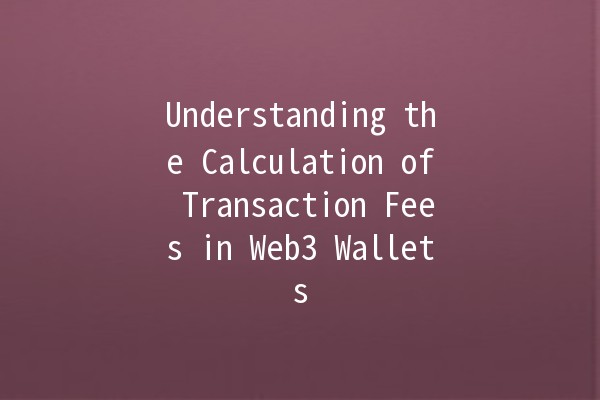
As the world of decentralized finance continues to evolve, understanding the mechanics behind Web3 wallets, particularly transaction fees, becomes increasingly important. These fees can significantly affect user experience and investment outcomes. In this article, we will delve into how transaction fees for Web3 wallets are calculated and provide practical tips for optimizing your wallet usage to save on these fees.
What are Web3 Wallets?
Web3 wallets are digital wallets designed to interact with decentralized applications (dApps) and handle cryptocurrencies. Unlike traditional wallets that are centralized and controlled by banks, Web3 wallets give users full control of their funds, utilizing blockchain technology for transactions. They can be classified into two main categories:
Understanding Transaction Fees in Web3 Wallets

Transaction fees in Web3 wallets are influenced by several factors including network congestion, the type of transaction, and the gas price set by the user. Let’s break down these components:
In blockchain networks like Ethereum, transaction fees are often referred to as "gas." Gas price is the amount a user is willing to pay for their transaction to be processed by miners. It is typically quoted in Gwei (a denomination of Ether).
Example: If the gas price is set at 100 Gwei and a transaction requires 21,000 gas units, the total fee would be:
\[
\text{Total Fee} = \text{Gas Price} \times \text{Gas Units} = 100 \, \text{Gwei} \times 21,000 = 2,100,000 \, \text{Gwei} = 0.0021 \, \text{ETH}
\]
During periods of high demand, such as during an NFT drop or a major token sale, network congestion can drive gas prices up. Users must adjust their gas prices based on current network conditions to ensure timely transaction processing.
Different types of transactions may incur varying fees. For instance, deploying a smart contract generally incurs higher fees compared to a simple token transfer due to the complexity and resources required.
Many Web3 wallets allow users to manually set gas prices or choose from predefined options (e.g., slow, average, fast). This feature allows users to align their transaction urgency with appropriate fees.
As transaction fees due to congestion become increasingly problematic, Layer 2 solutions such as Polygon and Optimistic Rollups have emerged to mitigate these costs. These solutions offer lower fees by processing transactions off the main chain while still ensuring security.
Tips to Optimize Transaction Fees in Web3 Wallets
Here are five practical tips to help users optimize their transaction fees in Web3 wallets:
Using tools like Gas Station or EthGasStation allows users to monitor realtime gas prices, helping them choose the optimal time for their transactions. This can significantly reduce fees.
Practical Application: Before attempting a transaction, check the gas prices on these platforms to determine the best time to execute.
If you have multiple transactions to make, consider batching them together if your wallet supports it. This can help minimize total fees since you're paying gas for one transaction instead of several.
Practical Application: If you're sending funds to multiple addresses, group them to execute in a single transaction.
Where feasible, consider conducting transactions on Layer 2 solutions to benefit from lower fees and faster transaction speeds.
Practical Application: If you routinely buy or sell NFTs, using a Layer 2 network can save substantially on gas fees compared to the Ethereum mainnet.
Take advantage of your wallet's gas settings. If nonurgent, setting a lower gas price may still get your transaction processed during offpeak hours without additional costs.
Practical Application: For routine transfers, select a lower gas price option if timing is not critical.
Engaging with communities on social media platforms or following crypto news sites can help you stay updated on major events that could influence network congestion.
Practical Application: Participate in forums such as Reddit or Twitter discussions to receive firsthand updates, allowing you to plan transactions for optimal pricing.
Common Questions about Web3 Wallet Transaction Fees
Transaction fees can vary widely depending on network conditions and activities at the time of the transaction. Typically, fees can range from a few cents during low congestion to upwards of hundreds of dollars during peak times. Keeping an eye on gas prices via monitoring tools can provide you with a clearer expectation.
Reducing fees can be accomplished through several strategies: monitoring realtime gas prices, batching transactions, and taking advantage of Layer 2 solutions. Always adjust your gas settings based on urgency and market conditions.
Longer transaction times during high fee periods are primarily due to the prioritization of transactions by miners. Those willing to pay higher gas fees will have their transactions processed first, causing those who offer lower fees to wait longer for their turns to be mined.
Yes, most Web3 wallets provide options for users to manually set their gas prices. This feature allows for more control over the timing and costs associated with your transactions.
If a transaction fails, the gas used for the failed transaction is not refunded. Only the gas spent processing the transaction (if any) is lost. Therefore, choosing the right gas settings is crucial.
No, transaction fees vary between blockchain networks. Different networks have different fee structures and methods for calculating fees. For instance, Bitcoin uses a different model than Ethereum, and networks like Solana or Binance Smart Chain typically offer lower fees.
, understanding how transaction fees work in Web3 wallets and employing strategies to optimize fee management can greatly enhance your experience in the decentralized namespace. Embracing best practices for transaction efficiency not only saves money but also contributes to a smoother interaction with the evolving world of cryptocurrency.

